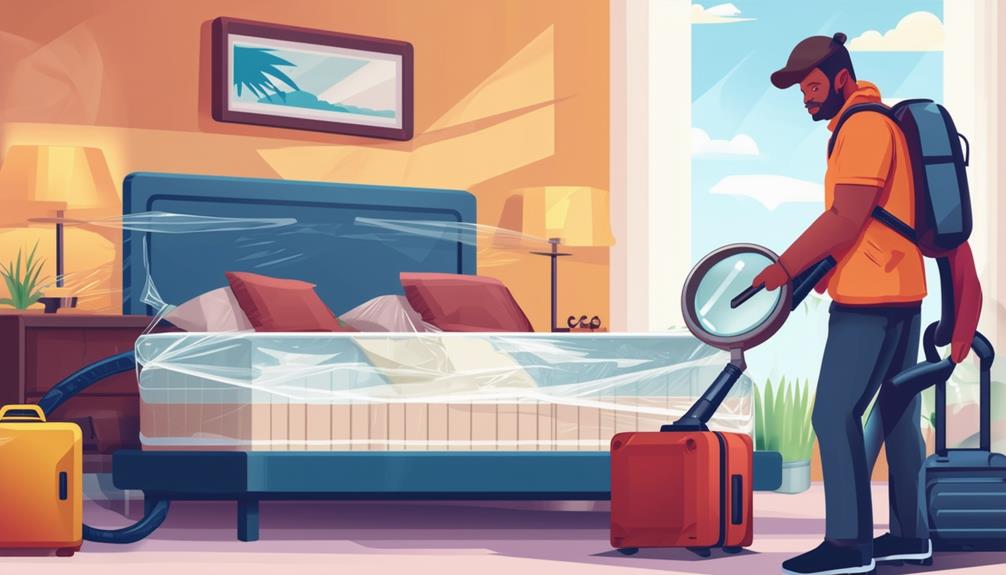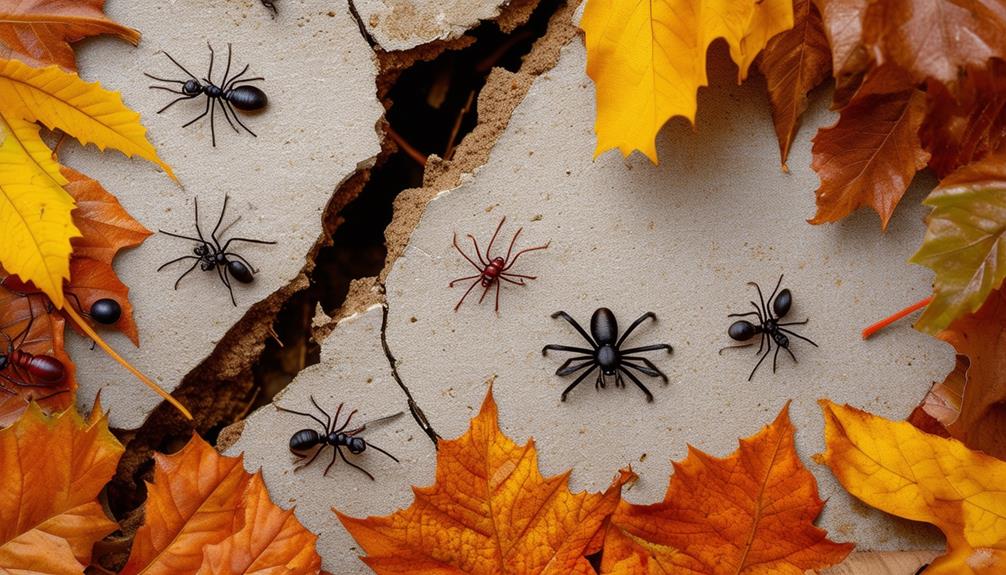As a traveler, you understand the importance of a comfortable and bug-free stay during your adventures. But have you considered the tiny yet persistent bed bugs that could potentially disrupt your journey? By following a few simple tips and tricks, you can safeguard yourself from these unwanted guests and guarantee a peaceful night’s rest wherever you go. Stay tuned to discover the key strategies that will help you steer clear of bed bugs while on the road, making your travel experiences worry-free and enjoyable.
Key Takeaways
- Inspect hotel rooms thoroughly for bed bugs before unpacking.
- Use hard-sided luggage to minimize bed bug hiding spots.
- Keep luggage off soft surfaces to avoid bed bug hitchhiking.
- Wash clothes in hot water post-travel to kill any bed bugs.
- Consider using protective covers and sealed bags for luggage.
Bed Bug Prevention Tips for Travelers
To prevent bed bugs while traveling, meticulously inspect hotel rooms, beds, and furniture for any signs indicating their presence, such as blood stains and fecal spots.
Bed bugs are small, reddish-brown insects that feed on blood and can hide in cracks and crevices of furniture, mattresses, and walls. These pests are expert hitchhikers and can easily latch onto luggage or clothing, making hotel rooms a common site for infestations.
When entering a hotel room, avoid placing luggage on beds or soft surfaces where bed bugs may lurk. Instead, use sealable plastic bags to store your belongings and consider using a garment steamer or high heat to kill any potential bed bugs.
If you suspect a bed bug infestation, contact a licensed pest control professional for further inspection and guidance. By being vigilant and taking these precautionary measures, you can reduce the risk of encountering bed bugs during your travels.
Inspecting Hotel Rooms for Bed Bugs
When inspecting hotel rooms for bed bugs, start by using a flashlight to thoroughly examine seams, corners, and crevices of the mattress, box spring, and headboard. Check behind picture frames, baseboards, and electrical outlets for signs of bed bug activity, such as live bugs, eggs, shed skins, or dark spots.
Remember to also pay attention to any musty odors or unusual sweet scents, as they could indicate the presence of bed bugs in the room.
Room Inspection Checklist
Inspect hotel rooms for bed bugs by meticulously checking under linens, pillows, mattress seams, behind the headboard, and along the bed frame using a flashlight. When conducting your room inspection, be sure to:
- Examine the suitcase stand and luggage rack for any signs of bed bugs.
- Inspect the carpet edges and any cracks or crevices in the room.
- Check the curtains and upholstered furniture thoroughly for any indications of bed bug activity.
Signs of Infestation
Upon entering a hotel room, meticulously examine various areas for small black or brown stains, shed skins, and tiny translucent eggs, as they serve as clear indicators of a potential bed bug infestation. To effectively inspect for signs of infestation, check under the linens, pillows, and seams of the mattress. Additionally, inspect the sides of the mattress, box spring, and bed frame for any evidence of bed bug activity. Use a flashlight to examine behind the headboard and other furniture near the sleeping area for bugs. Below is a table summarizing key areas to inspect for signs of bed bugs in a hotel room:
| Areas to Inspect | Signs of Infestation |
|---|---|
| Linens and pillows | Small black or brown stains |
| Mattress seams | Shed skins |
| Bed frame | Tiny translucent eggs |
| Behind headboard | Live bugs |
| Furniture near bed | Blood spots |
Storing Luggage in Bathroom
For effective prevention of bed bugs while traveling, consider utilizing the bathroom to store your luggage. When it comes to keeping bed bugs away from your personal items, the bathroom can be a strategic location. Here are some key points to keep in mind:
- Isolation: Placing your suitcase in the bathroom can create a barrier that prevents bed bugs from accessing your belongings.
- Avoiding Soft Furniture: By storing your luggage in the bathroom, you reduce the chances of bed bugs hiding in soft furniture like beds or couches.
- Minimizing Contact: Hanging your clothes on hooks in the bathroom can help minimize contact with potentially infested surfaces, further reducing the risk of bringing bed bugs home.
Utilizing the bathroom as a storage space for your belongings while traveling can noticeably decrease the likelihood of encountering bed bugs during your trip. Remember, prevention is key when it comes to dealing with these pesky insects.
Keeping Clothing in Sealed Bags
To safeguard your clothing from potential bed bug infestations, it is advisable to store them in sealed plastic bags while traveling. Sealed plastic bags play an important role in preventing bed bugs from spreading to your belongings. These sealable plastic bags help contain any bed bugs or eggs that may be present on your clothing, reducing the risk of infestation. By keeping your clothing securely sealed in bags, you not only minimize the chance of bed bug exposure but also prevent the spread of these pests to other items in your luggage. Additionally, sealed bags make it easier to spot and address any potential bed bug issues during your travels promptly.
| Benefits of Keeping Clothing in Sealed Bags | |
|---|---|
| Prevents bed bug infestations | Contains any bed bugs or eggs |
| Minimizes risk of spreading bed bugs | Easier identification of bed bug issues |
| Reduces exposure to bed bugs | Helps maintain hygiene while traveling |
| Prevents infested items in your luggage | Ensures peace of mind during your trip |
| Easy to spot and address bed bug problems |
Opting for Hardside Luggage
When considering ways to prevent bed bug infestations while traveling, opting for hardside luggage is a recommended measure by the Tulsa Department of Health. Here are some reasons why hardside luggage can help protect you from bed bugs:
- Fewer Hiding Spots: Hardside luggage has fewer folds and seams compared to fabric suitcases, reducing hiding spots for bed bugs.
- Harder Surface for Bed Bugs: Bed bugs are less likely to infest hardside luggage due to its smooth and hard surface that’s harder for them to hide in.
- Easier Inspection and Cleaning: Opting for hardside luggage can make it easier to spot and clean any potential bed bugs or eggs that may be present.
Choosing Well-Lit Seating Areas
Consider selecting seating areas that are brightly illuminated when traveling to minimize the risk of encountering bed bugs during your trip. Opting for well-lit seating areas in airports or public transportation hubs can greatly reduce the likelihood of bed bug infestations. Brightly lit spaces make it easier to spot any signs of bed bugs on your belongings or clothing, allowing you to take immediate action. Additionally, well-lit areas are less attractive to bed bugs as they prefer dark and secluded spots for hiding. By choosing well-lit seating, you decrease the chances of these pests hitching a ride on your luggage or clothing.
Dark and secluded seating areas provide bed bugs with ample hiding spots, increasing the risk of them latching onto your belongings unnoticed. Hence, by consciously avoiding such areas and opting for well-lit seating instead, you create a less favorable environment for bed bugs to thrive. Ultimately, prioritizing well-lit seating areas can help safeguard you from unknowingly bringing bed bugs home from your travels.
Avoiding Luggage Racks in Hotels
When traveling, be cautious of using luggage racks in hotels as they can be hiding spots for bed bugs. Bed bugs can easily hide in the crevices and seams of these racks, potentially infesting your belongings.
To avoid this, opt for using luggage stands or storing your luggage on hard surfaces instead.
Bed Bug Hiding Spots
Bed bug infestations commonly lurk in hotel luggage racks, making them a potential hotspot for these pests. When it comes to bed bug hiding spots, luggage racks in hotels can be particularly problematic. Here are some key points to keep in mind:
- Bed bugs can easily hide in the crevices and folds of luggage racks.
- Shared luggage racks increase the risk of bed bug transfer between suitcases.
- Inspecting luggage racks before use can help you avoid potential infestations.
To prevent bed bugs from hitching a ride home with you, it’s important to keep your personal items off luggage racks and store them in sealed bags when traveling. Being vigilant about where you place your belongings can go a long way in protecting yourself from these pesky pests.
Use Luggage Stands
Opting for luggage stands over luggage racks in hotels provides a more secure storage option, minimizing the risk of bed bug infestations during your travels. Luggage stands are a cleaner alternative, less likely to harbor pests that could latch onto your belongings. Placing your suitcase on a luggage stand can help keep the suitcase elevated and away from potential bed bug hiding spots.
Unlike luggage racks, which may have hidden bed bugs, luggage stands offer a safer storage solution for your luggage. By choosing luggage stands, you’re taking a proactive step in safeguarding your belongings from bed bug infestations. Remember, prevention is key, and using luggage stands can significantly reduce the chances of bringing bed bugs home with you.
Inspect Luggage Racks
To guarantee a bed bug-free travel experience, thoroughly examine hotel luggage racks for any signs of infestation before placing your belongings on them.
- Inspect luggage racks in hotels for any signs of bed bugs, such as live bugs, eggs, or fecal stains.
- Bed bugs can hide in cracks and crevices of luggage racks, so use a flashlight for a thorough inspection.
- Avoid placing your luggage directly on luggage racks; consider using a hard surface or bathroom instead.
Minimizing Risk of Infestation
When traveling, one should meticulously examine hotel rooms for any indications of bed bugs to minimize the risk of infestation. Look for dark spots on bedding or furniture, which could be a sign of their presence.
Additionally, keep your luggage off beds and floors to prevent bed bugs from hitching a ride back home. Opt for hardside suitcases with fewer seams and folds, as this reduces hiding spots for bed bugs.
After traveling, wash your clothes in hot water and vacuum your luggage thoroughly to eliminate any potential bed bugs that may have tagged along. It’s also a good idea to contemplate using protective covers for your luggage and storing your belongings in sealed plastic bags to prevent infestations.
These simple steps can go a long way in safeguarding yourself from the unpleasant experience of dealing with bed bugs while traveling.
Preventing Bed Bugs While Traveling
Inspecting hotel rooms thoroughly is key to preventing bed bugs from hitching a ride back home with you while traveling. When it comes to preventing bed bugs while on the road, here are some essential tips to keep in mind:
- Use hard-shelled suitcases: Opt for luggage that bed bugs can’t easily penetrate, reducing the risk of infestations.
- Avoid placing luggage on soft surfaces: Keep your bags off beds and sofas to minimize contact with potential bed bug hotspots.
- Inspect hotel rooms diligently: Check beds, bathrooms, and drapes for any signs of bed bugs to prevent bringing them home with you.
Protecting Against Unwanted Pests
Using hardside luggage is a practical measure to safeguard against unwanted pests like bed bugs during travel. Unlike fabric materials, which can harbor bed bugs, hardside luggage provides fewer hiding spots for these pesky insects.
When in airports, opt for bright and less secluded seating areas to minimize the risk of bed bug exposure. Additionally, store your luggage in the bathroom upon arriving at your destination in New York, as the high heat in bathrooms can help deter bed bugs.
To further protect against infestations, avoid using luggage racks in hotel rooms, where bed bugs can easily transfer. It’s also wise to keep your clothing in sealed bags while inspecting hotel rooms for signs of bed bugs.
Frequently Asked Questions
How to Protect Against Bed Bugs While Traveling?
To protect against bed bugs while traveling, inspect hotels thoroughly and check luggage for signs of infestation. Be meticulous in examining mattresses, headboards, and furniture. Keep luggage elevated and sealed in plastic to minimize exposure risks.
How to Avoid Bed Bugs on Public Transportation?
To avoid bed bugs on public transportation, practice good train etiquette and bus hygiene. Keep personal items off seats, use protective covers, and be cautious of storage areas. If you suspect bed bugs, report for inspection and treatment.
How Do You Prevent Bed Bugs in Your Car?
When preventing bed bugs in your car during car camping or on a road trip, inspect upholstery and crevices. Vacuum seats and trunk regularly. Avoid second-hand items. Use bed bug-proof covers if infested. Seek professional help if needed.
How Do I Keep Guests From Bringing Bed Bugs?
To keep guests from bringing bed bugs, emphasize guest etiquette. Encourage thorough luggage inspection before and after travel. Advise using hard-shelled suitcases and plastic bags. Educate on bed bug signs and hotel room inspections. Use high heat for laundry.





